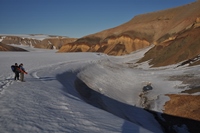Earth’s escape from its ancient “deep freeze”

A field party surveying the geology of north east Spitsbergen, amongst the highland ice fields where “Snowball Earth” rocks were found. Image: Professor Mike Hambrey.
01 September 2015
An international team of scientists, including Professor Michael Hambrey of Aberystwyth University’s Centre for Glaciology, has discovered how our planet may have escaped from a global deep-freeze about 635 million years ago.
Their research, funded by the Natural Environment Research Council, has recently been published in the journal Nature Geoscience, in an article led by Professor Doug Benn of the University Centre on Svalbard.
The team, co-ordinated by Professor Ian Fairchild of Birmingham University, includes scientists from the UK, Norway, France and the USA.
The idea of a deep-frozen world was first developed by the well-known Cambridge geologist, the late Brian Harland, in the 1960s.
Working with him in the late 70s and 80s on projects in Greenland and Spitsbergen (Svalbard, Arctic Norway), Hambrey and Fairchild provided evidence for a “Tropical Ice Age”.
However, the concept of a “Snowball Earth” only attracted the attention of the media and the wider geological community in the 1990s, and the theory has not been universally accepted.
The global ice age that is now envisaged, called the Marinoan, took place shortly before the emergence of animals, and these events are linked. The problem was that, although it was easy to enter an ice age, it was thought by some to be difficult to escape.
Climate modellers found that low carbon dioxide could trigger the growth of ice sheets all over the planet.
The snow and ice would have reflected back nearly all the sun’s radiation into space, making it difficult for Earth to escape from its ice age, except for one thing: volcanoes.
Erupting volcanoes beneath the ice sheets would eventually have delivered enough carbon dioxide into the atmosphere to produce a greenhouse effect, and cause the ice sheets to disintegrate.
However, climate models still found it difficult to plausibly describe how Earth could have shed its ice cover.
The research team’s article now provides the first full explanation for how the Marinoan Ice Age finished, along with the accompanying rise in sea level of several hundred metres.
Slight wobbles of the Earth’s spin axis caused variations in the heat received at different places on the planet’s surface.
These changes were small, but enough over thousands of years to cause a change in those regions where snow accumulated or melted, leading the glaciers to advance and recede.
Earth was left looking just like the McMurdo Dry Valleys in Antarctica – arid, with lots of bare ground, but also containing a nearby ice sheet up to 3 kilometres thick.
Earth in this state would have been darker than previously envisaged, absorbing more of the sun’s radiation, allowing the warm-up necessary for escape from the “Snowball”.
These results were obtained from several season’s fieldwork on rocks in the High-Arctic Norwegian island of Spitsbergen, and a battery of laboratory experiments on hundreds of specimens collected.
The fieldwork involved deployment by helicopter of the team with tents and supplies onto high inland icefields, prone to severe blizzards even in mid-summer.
However, pristine exposures of rock revealed abundant glacial deposits associated with limestones, and high carbon dioxide values were obtained from these rocks.
The conclusion was that these sediments represent the tail-end of the Marinoan ice age, when the changed atmosphere was causing the ice to melt.
However, this melting phase had its own fluctuations, caused by the wobble in Earth’s axis, just like the recent ice ages that we have been flipping in and out of over the last 2 million years.
These results were tested by climate modellers from Paris, and they found good agreement with the field and experimental work.
So, after several million years of being frozen, our icy Earth with a warming atmosphere reached a transitional stage, which matches the conditions found in present-day Antarctica and the Arctic, even though Spitsbergen occupied a near-equatorial position at that time.
This transitional period lasted around 100,000 years before the glaciers melted and global sea levels rose dramatically.
Conditions were thus set for the subsequent dramatic evolution of life on Earth.
Professor Mike Hambrey said: “This very exciting project has brought together the skills of glaciologists, geochemists, geophysicists and numerical modellers to resolve one of the most intractable problems in Geology.
“The fieldwork in Spitsbergen was challenging at times, especially when we had to regroup after storms destroyed our camps, but we are pleased with the large amount of data we have collected.
“Our new paper will be the first of many, covering not just Spitsbergen but also Northeast Greenland, where we have also worked.”
AU28615



